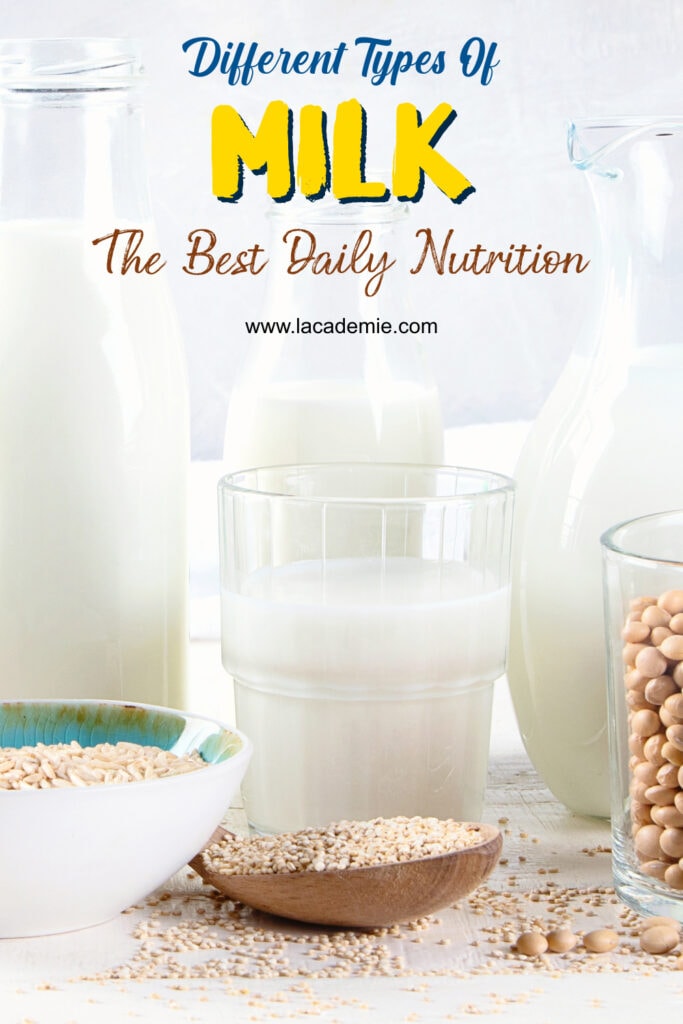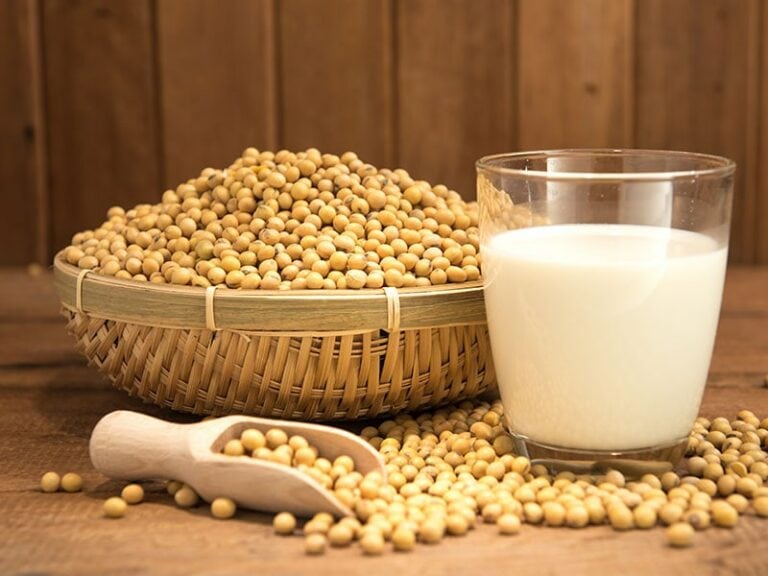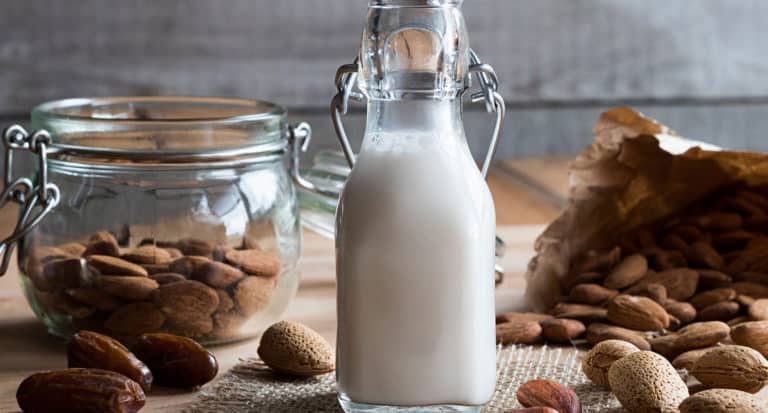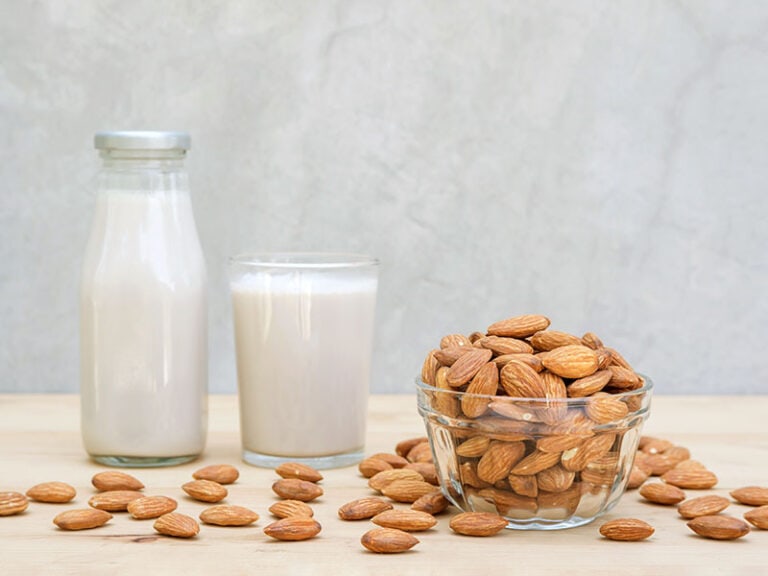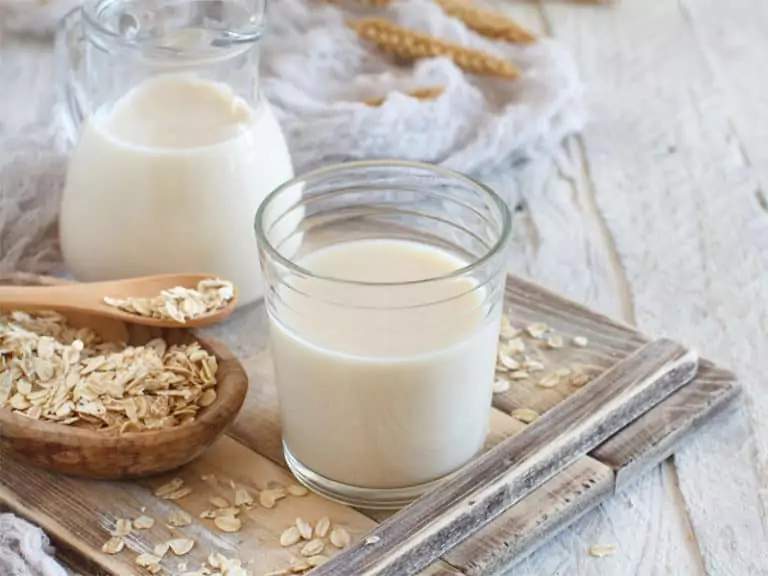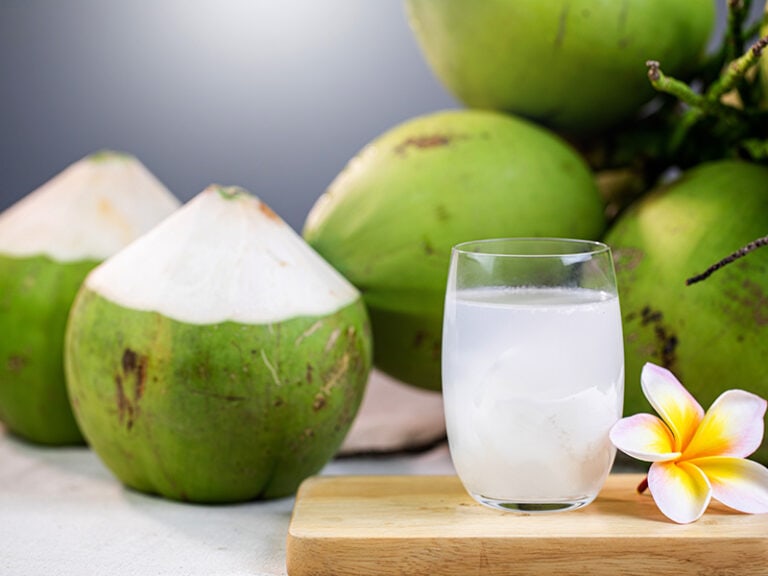Different types of milk provide a diverse shade of taste to your meal. If you’re wondering whether your milk is gluten-free, vegan-friendly, etc., this article will help you. After reading this post, you can choose the most suitable milk, from animal-based milk to plant-based milk.
Milk is a crucial ingredient in our everyday meals. It contributes nutrients and gives your meal a rich and creamy flavor. So, let’s dive into this list and discover all the best types of milk you can add to your fridge.
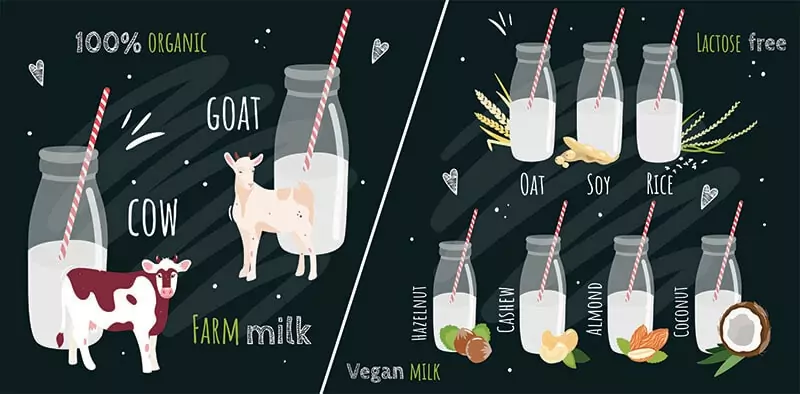
Let’s Look At These Plant-Based Milk (Non-Dairy Milk)
Plant-based milk is a dazzling kind of drink that benefits your health. Its taste, in general, is mild with a mellow touch of nutty flavor. So, explore this type of milk right here.
1. Almond Milk
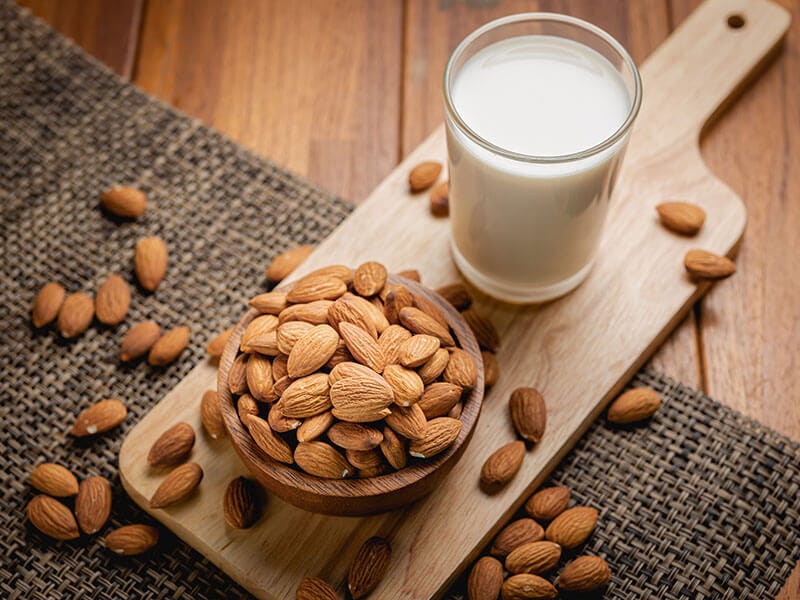
Nutrition facts (one cup/240ml): Calories: 39, Fat: 3 grams, Protein: 1 gram, Carbs: 3.5 grams, Fiber: 0.5 grams, Calcium: 24% of the Daily Value (DV), Potassium: 4% of the DV, Vitamin D: 18% of the DV, Vitamin E: 110% of the DV
This milk is full of nutty taste with a touch of creaminess from almonds. The milk has a magnificent white color that contains no cholesterol or lactose. The fat content of almond milk is relatively low, so it is an excellent healthy drink for you.
Almonds are native to the Middle East and Western Asia, but you can find them everywhere these days. Almond milk is an excellent choice for those who are lactose-intolerant or follow a vegetarian diet without dairy products.
If you wonder if almond milk will go bad, the answer is yes, and you need to store it in the fridge for more prolonged use. Don’t be worried because its taste will remain the same if you store it properly.
Is it possible to freeze almond milk for longer use? Sure, you can store it in the freezer for up to six months, but its taste will not remain the same after the thawing process.
You can find commercial almond milk in almost any supermarket or grocery store near your house. Making it from raw almonds with a food blender is also a great option. Almond milk can be flavored with vanilla or chocolate with sweetened or unsweetened versions.
You can make a refreshing cup of almond milk for your breakfast.
2. Oat Milk
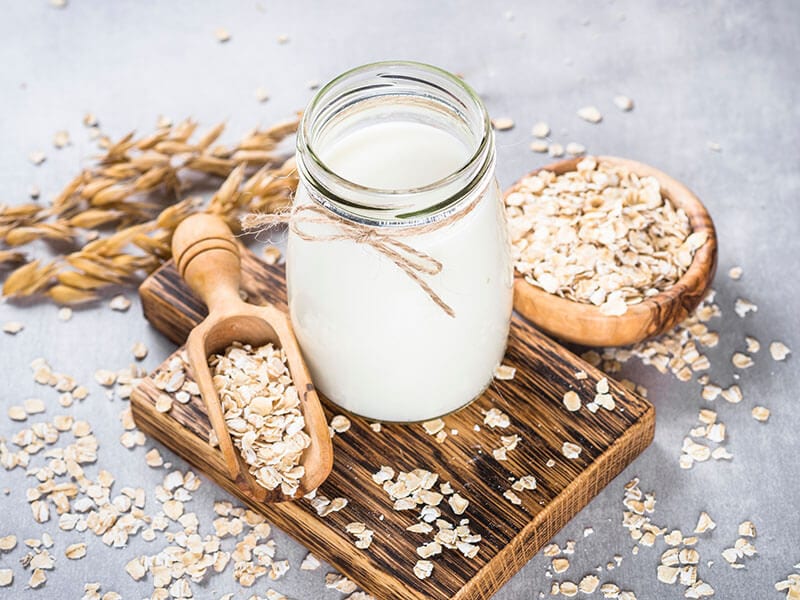
Nutrition facts (one cup/240ml): Calories: 130, Fat: 2.5 grams, Protein: 4 grams, Carbs: 15 grams, Fiber: 2 grams, Calcium: 35% of the Daily Value (DV), Vitamin D: 25% of the DV.
If you have no idea what to have for breakfast, oat milk will be an excellent option for you. It is made from rolled oats and water with a creamy texture. Sometimes, other ingredients are added for flavors like vanilla and chocolate (mostly manufactured products)
This milk is full of oat aroma that you will love. Oak milk became popular after its development in the 1990s by Rickard Öste (a Swedish scientist). This drink is the top two consumed plant-based milk in the U.S. in 2020, ranked after almond milk.
This drink is perfect for vegans and those who have an allergy to cow milk or are lactose-intolerant. Oat milk can be used for yogurt alternatives, ice cream, or coffee creamer. Interestingly, its production is regarded as an environmentally-friendly process.
3. Cashew Milk
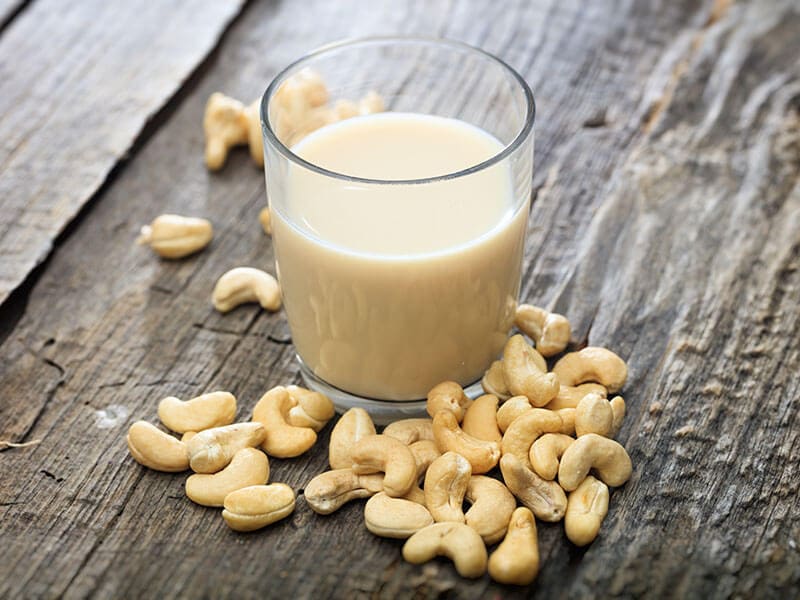
Nutrition facts (one cup/240ml): Calories: 156, Fat: 11 grams, Protein: 4.5 gram, Carbs: 10.5 grams, Fiber: 2 grams, Calcium: 18.9 grams, Iron: 1.8mg, Sugar: 3 gram, Sodium: 100mg.
Cashew is packed with healthy nutrients and unsaturated fat. People often soak cashew overnight before blending it with water. The outcome is thick and creamy milk that will charm your heart.
Usually, people enjoy cashew milk with its original texture, so you don’t need to strain the milk. Don’t worry about the pulp; if you use a powerful blender, there will be no pulp left in your milk. However, you can still filter the milk to meet your desire.
Cashew milk will last about four days in the fridge (homemade version), and you should consume the milk before this day. For the manufactured cashew milk, you need to check the shelf life duration on the package.
4. Soy Milk
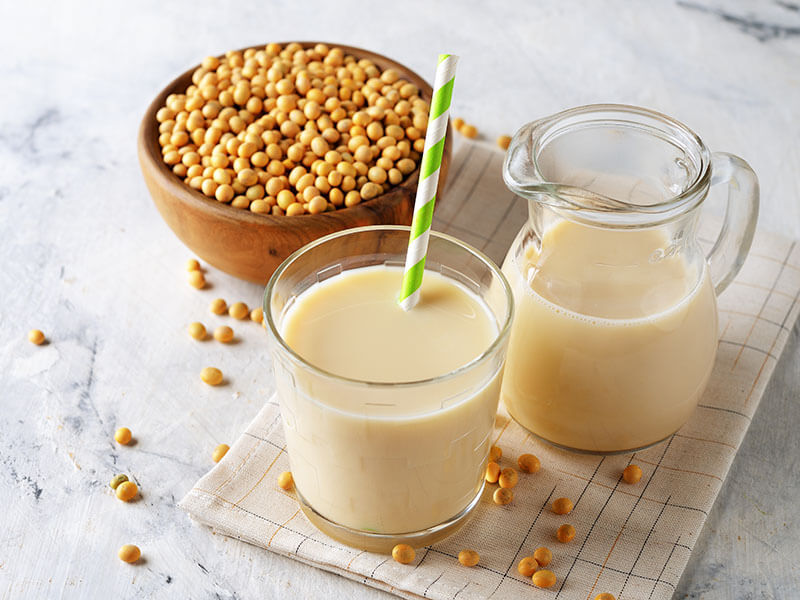
Nutrition facts (one cup/240ml) unsweetened soy milk: Calories: 80, Fat: 4 grams, Saturated fat: 0.5 grams, Carbohydrates: 3 grams, Fiber: 2 grams, Sugars: 1 gram (0 g added sugars), Protein: 7 grams.
Let’s explore one of the most famous non-dairy milk in the world, soy milk (also known as soya milk). This milk has a mellow nutty flavor from soy. The aroma from soy is also a charming feature of this milk.
People often use soy milk as an alternative choice for dairy milk. The milk originated in China and became one of the top prominent plant-based beverages consumed worldwide.
Soy milk is available as a manufactured product, or you can make it as a homemade drink by blending soybeans with water before boiling the mixture into a delicious drink.
You need to check the soy milk shelf life for commercial products to enjoy their best flavor. For the homemade one, you can store it in the fridge for around two days. Soy yogurt, soy cream, bread, or even mayonnaise are typical soy milk products.
Is it easy to make soy milk? Let’s find out!
5. Hemp Milk
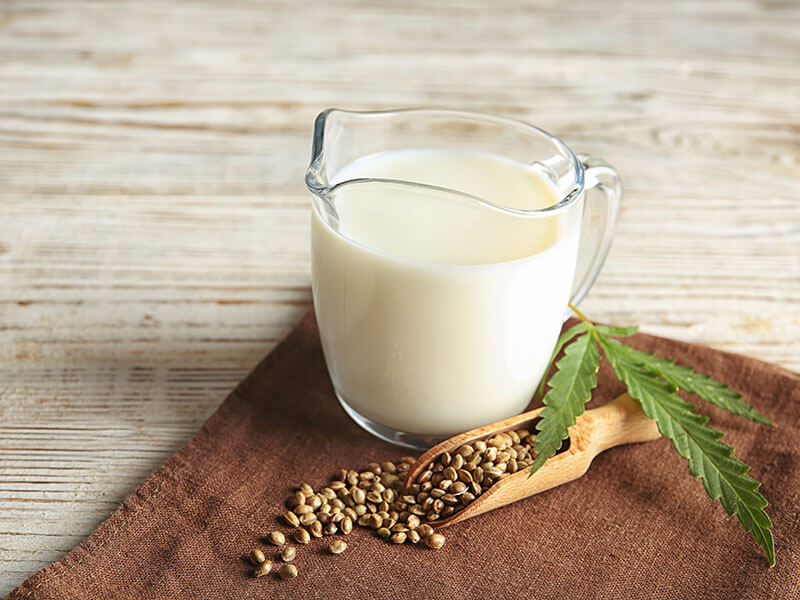
Nutrition facts (one cup/240ml): Calories: 83, Carbs: 1.3 grams, Protein: 4.7 grams, Fat: 7.3 grams, Calcium: 2% of the DV, Iron: 7% of the DV.
Who likes hemp seeds? I’m sure you will love the milk made from this seed. Hemp milk has a similar texture and color to ordinary milk. The milk can be flavored with different ingredients (like vanilla or vanilla extract) or simply sweetened for an amazing taste.
Like other plant-based milk, hemp milk requires blending the seeds with water. You can use a strainer to filter the pulp, but enjoying the drink without filtering is also common. Resembling cow milk in texture, hemp milk is an excellent option for making latte coffee.
6. Rice Milk
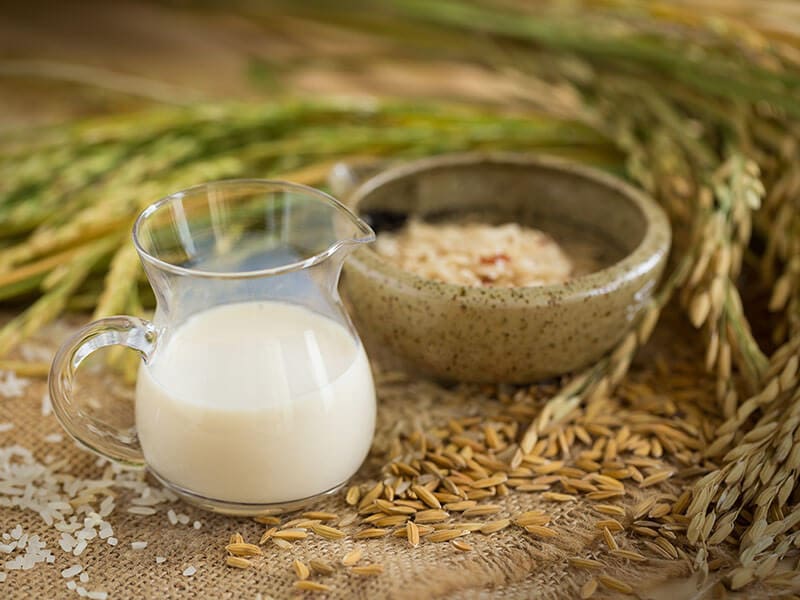
Nutrition facts (one cup/240ml): Calories: 115, Fat: 2.4 grams, Sodium: 95.2mg, Carbohydrates: 22.4 grams, Fiber: 0.7 gram, Sugars: 12.9 grams, Protein: 0.7 gram, Calcium: 288 mg, Vitamin A: 154mcg, Vitamin B12: 1.54mcg, Vitamin D: 2.4mcg.
Don’t you love the gentle aroma of rice? If so, the taste of rice milk will meet your desire. The recipe of rice milk was first recognized in Meatless Cookery (a cookbook by Maria M. Gilbert) in 1914.
Rice milk is a wonderful choice to replace cow milk or any dairy product. However, the Food Standards Agency in the U.K. suggests that children under five should not consume this milk as an alternative to formula milk or breast milk.
White, brown rice or brown rice syrup (often in commercial products) are typical choices for making rice milk. People will add sugar or any other sweetener to flavor this milk. You can also choose the one with vanilla flavor.
This milk is an excellent source of vitamin A, Calcium, and vitamin D. Therefore, it is a popular choice among vegans.
7. Coconut Milk
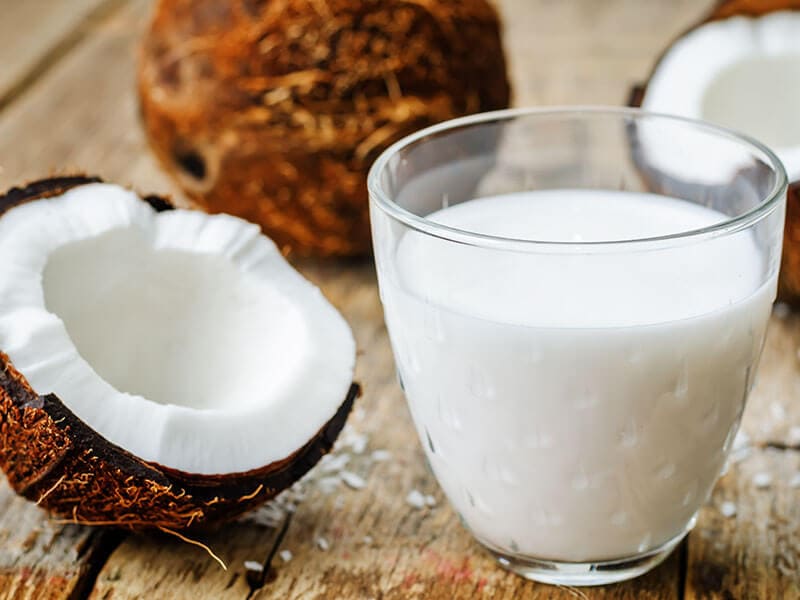
Nutrition facts (one cup/240ml): Calories: 552, Fat: 57 grams, Protein: 5 grams, Carbs: 13 grams, Fiber: 5 grams, Vitamin C: 11% of the Reference Daily Intake (RDI), Folate: 10% of the RDI, Iron: 22% of the RDI, Magnesium: 22% of the RDI, Potassium: 18% of the RDI, Copper: 32% of the RDI, Manganese: 110% of the RDI, Selenium: 21% of the RDI
If you love the rich and creamy taste of coconut, you will lose your head over this coconut milk. The milk is a smooth, slightly thick liquid made from grated mature coconuts. The milk has an opaque and milky-white color thanks to the high-oil content of mature coconut.
Coconut milk will complement any recipe with a dazzling buttery flavor. This milk is a specialty in tropical regions like Southeast Asia, East Africa, and the Caribbean.
Coconut milk has the highest fat content among plant-based milk. You will find thick coconut milk (or coconut cream) with 20 to 50% fat content, thin coconut milk with no more than 20% fat, and coconut skim milk with less than 1.5%.
People use coconut milk in food and drink recipes with either savory or sweet flavors. I bet this milk will allure you with its sophisticated taste.
This coconut milk will amaze you with its rich flavor.
Have You Tried These Types Of Dairy Milk?
Jump to this section to see if you love the rich flavor of milk produced by animals. You will be overwhelmed with the unique taste of this type of milk.
8. Whole Milk Or Full Cream Milk
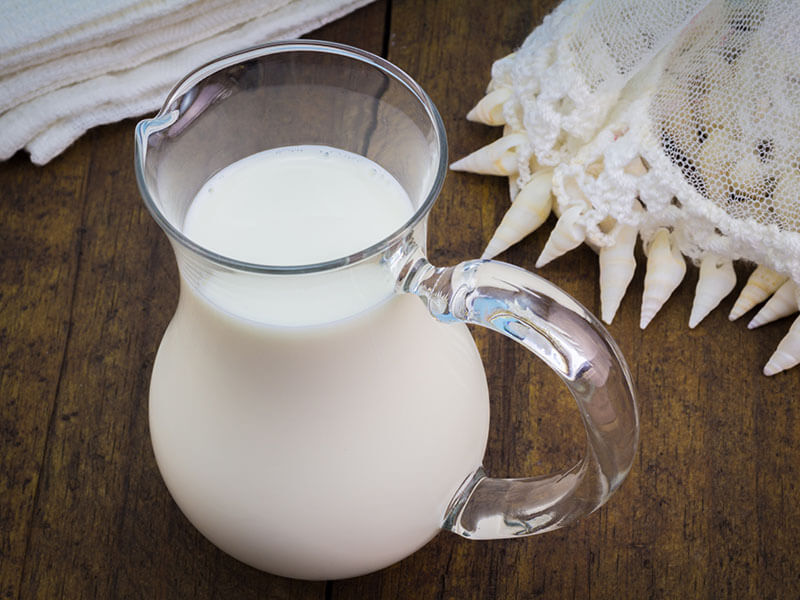
Nutrition facts (one cup/240ml): Calories: 149, Protein: 8 grams, Fat: 8 grams, Carbohydrates: 12 grams, Fiber: 0 grams, Sugar: 12 grams.
Whole milk is often used to refer to animal milk (the most common is cow milk) that has not been through any nutritional alteration. Whole milk needs to undergo a pasteurization process to guarantee food safety before use.
This milk keeps all its nutrients, so it is a healthy option for those who need a great nutrition source. Whole milk has higher fat content compared to other types of milk. This label requires at least 3.5 % fat (saturated fat) with a slightly thick texture.
The fat content in whole milk will create a satisfying feeling when enjoying the drink, making your stomach feel full longer than other milk.
9. Skim Milk Or Skimmed Milk (Fat-Free Milk)
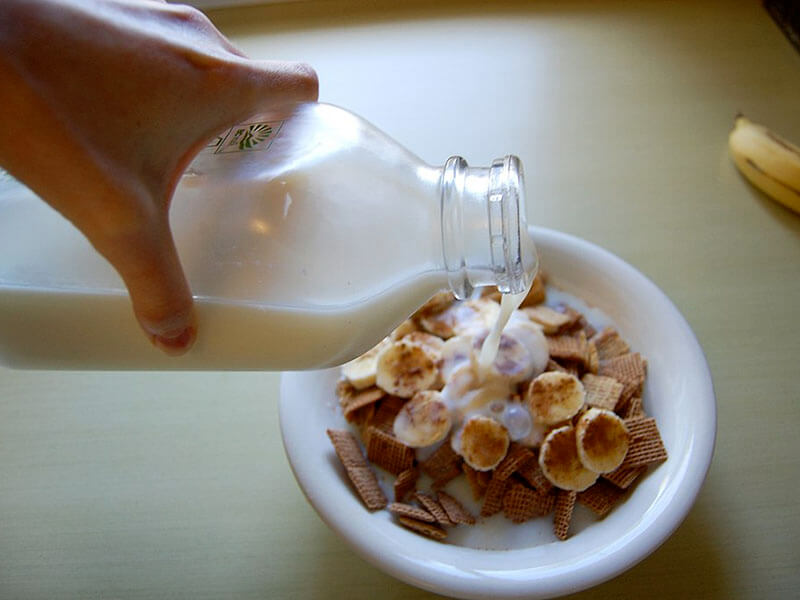
For those who are on a diet, just try Skim milk.
Nutrition facts (one cup/240ml): Calories: 90, Total Fat: 0g, Cholesterol: 5mg, Sodium 130mg, Potassium 410mg, Carbohydrate 13 grams, Protein 8 grams, Vitamin A 10% of the DV, Calcium 30% of the DV, Vitamin C 4% of the DV, Vitamin D 25% of the DV.
Skim milk (or fat-free milk) is a type of milk that has undergone a nutritional alteration to reduce its fat content. This milk only has around 0.1% of fat, which means almost no fat left in this type of milk.
This milk is a perfect choice for people who want to lower their calories consumption. The milky taste of skim milk is slightly adjusted after the alteration.
Although the fat is removed, some manufacturers often add sugar as a sweetener. The amount of sugar is usually higher than whole milk. So, you need to choose a sugar-free version if you want to cut most calories out of your meal.
Let’s put whole milk and skimmed milk on a scale to see what will suit you.
10. Raw Milk

Nutrition facts (one cup/240ml): Calories: 160, Total Fat: 9 grams, Sugar: 12 grams, Carbohydrates 12 grams, Protein 9 grams, Vitamin A 150 mcg, Calcium 400 mg, Vitamin C 4.8 mg.
Raw milk is basically whole milk that hasn’t gone through pasteurization or homogenization. It could be from buffalos, goats, camels, or sheep with a rich flavor and strong odor from the animal breast.
People often heat the milk to eliminate pathogens and lengthen the shelf life of raw milk. Consuming raw milk is believed to benefit your immune system and provide better taste and nutrition for you.
There are some reports about serious health problems due to consumption of raw milk from unreliable manufacturers, so you need to find a credible manufacturer to enjoy raw milk without any risk of infection. This type of milk is an ideal choice for making cheese, such as Gouda.
11. 2% Milk
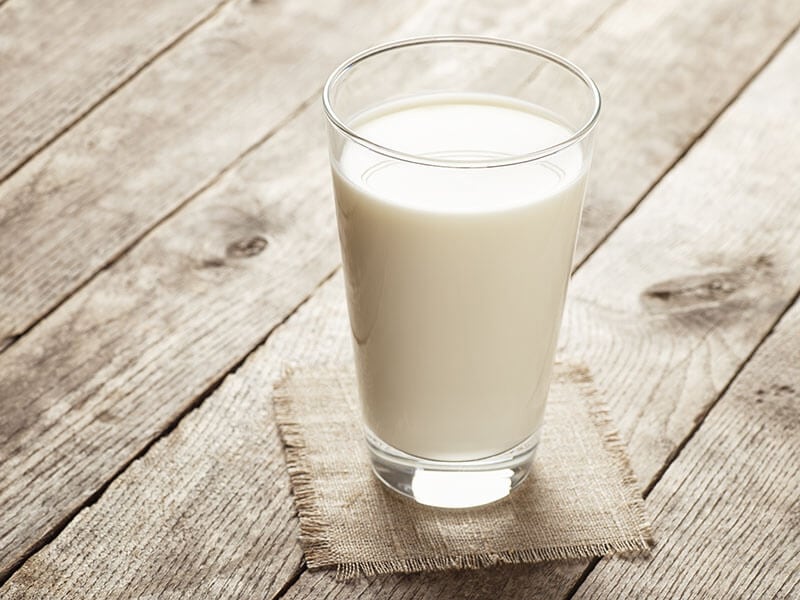
Nutrition facts (one cup/240ml): Calories: 130, Total Fat: 5g, Cholesterol: 20mg, Sodium 130mg, Potassium 400mg, Carbohydrate 12 grams, Protein 8 grams, Vitamin A 10% of the DV, Calcium 30% of the DV, Vitamin C 4% of the DV, Vitamin D 25% of the DV.
2% milk is perfect milk for those who love the balanced flavor. The milk is not too rich in fat, but it still has a creamy taste and a thick consistency (not too thick as whole milk and too thin like skim milk).
The milk has gone through a fat-removal process, but the fat content is then added back to it. It is rich in vitamins and minerals, which are perfect for kids. If you are considering whole milk and skim milk, 2% milk might meet your desire.
12. Low-Fat Milk
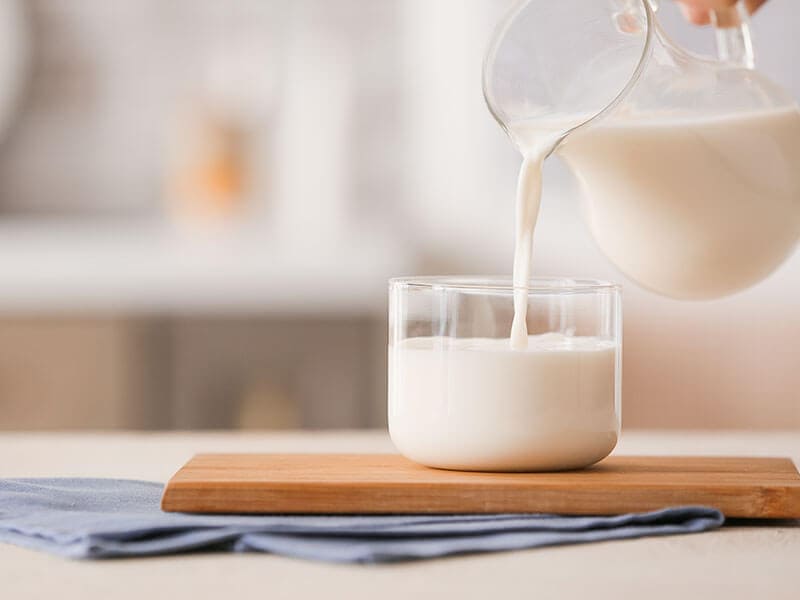
Nutrition facts (one cup/240ml): Calories: 110, Total Fat: 2.5g, Cholesterol: 10mg, Sodium 130mg, Potassium 400mg, Carbohydrate 13 grams, Protein 8 grams, Vitamin A 10% of the DV, Calcium 30% of the DV, Vitamin C 4% of the DV, Vitamin D 25% of the DV.
Low-fat has a fat content of around 1%. This milk has its fat removed, but the entire flavor is still rich and buttery. This milk is perfect for people who want to enjoy the milky flavor and control fat consumption.
Like skim milk, low-fat milk will be flavored with a larger amount of sugar than whole milk. Low-fat milk is thinner, and its flavor is milder than whole milk. The taste is richer than skim milk in general.
13. Toned Milk
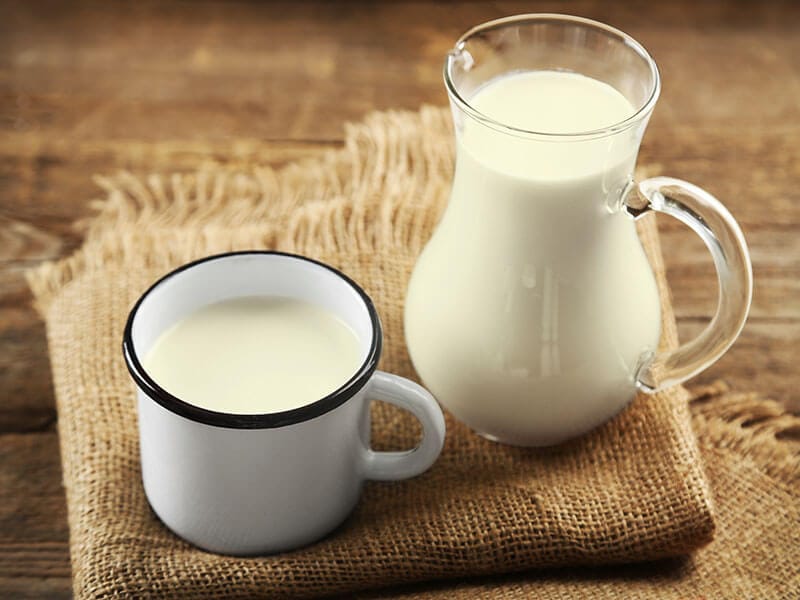
Nutrition facts (one cup/240ml): Calories: 58, Total Fat: 4 grams, Carbohydrates 5 grams, Protein 3 grams.
Let me introduce a unique milk from India, Toned milk. This type of milk is made by adding skim milk, water, and powdered skim milk to treat buffalo milk. Toned milk has lower fat content than whole milk, yet it is cheaper and available in a larger quantity thanks to the added ingredients.
Toned milk is common in areas with inadequate milk production. By toning the milk, its fat content will be around 3%, while the milk quantity will almost triple the original amount.
Double-toned milk is a variant of toned milk that UNICEF introduced to provide milk for low-income households and homeless people. The fat content of double-toned milk is only 1.5%, pasteurized before use.
14. Organic Milk
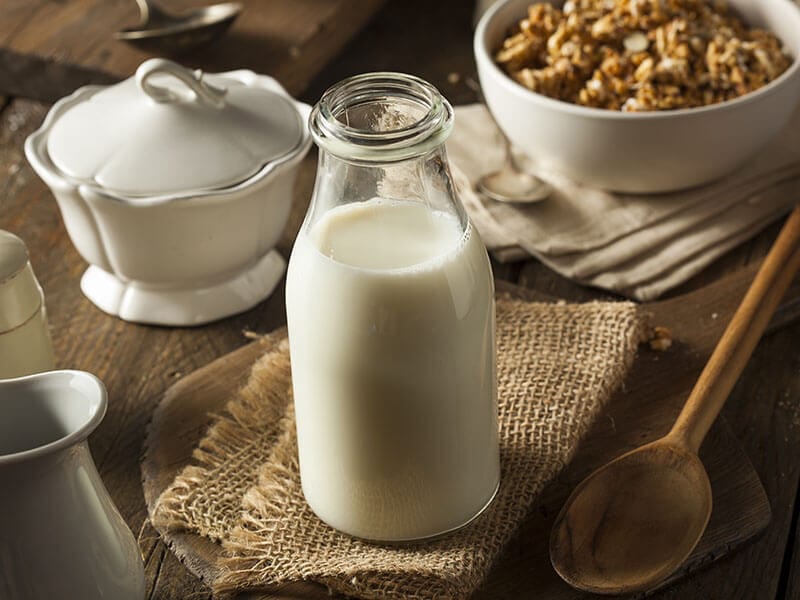
Nutrition facts (one cup/240ml): Calories: 160, Total Fat: 8 grams, Cholesterol: 35mg, Sodium 130mg, Carbohydrate 13 grams, Protein 8 grams, Vitamin A 10% of the DV, Calcium 25% of the DV, Vitamin B12 50% of the DV.
Organic milk is a healthy product that has a special production. The cows producing this milk mustn’t be treated with antibiotics. In addition, no hormones of any kind are not allowed in raising these cows.
And another notable feature is that the cows must have at least 120 days of eating on pasture (30% of their diet). Each country has different criteria to evaluate and label the milk. In general, almost no drugs are allowed, and the animals are raised humanely.
The taste and texture of organic milk are similar to ordinary milk, but it is considered a healthier choice than other manufactured products thanks to the absence of additives and growth hormones.
In return, these organic products have a higher price than other products because the owner has to pay more for the production process.
15. Lactose-Free Milk
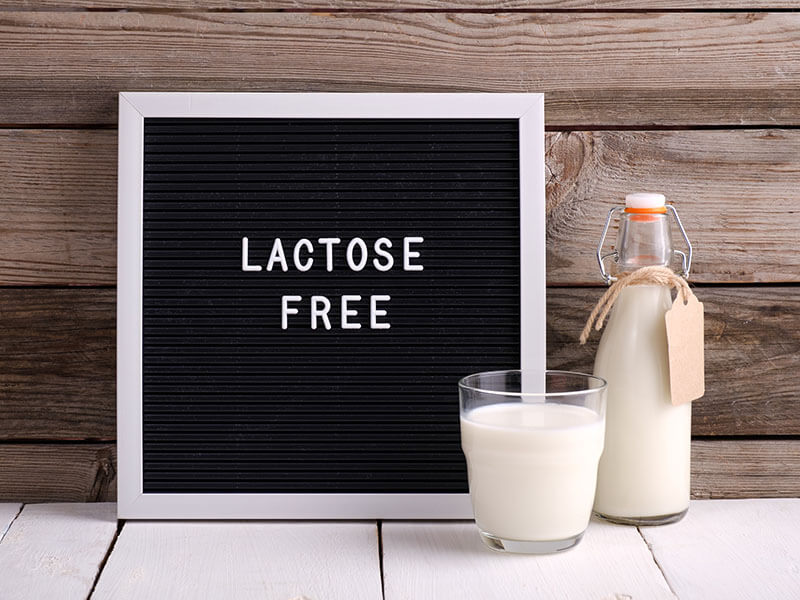
Nutrition facts (one cup/240ml): Calories: 160, Total Fat: 9 grams, Cholesterol: 35mg, Sodium 130mg, Carbohydrate 13 grams, Protein 8 grams, Vitamin A 6% of the DV, Calcium 30% of the DV, Vitamin D 25% of the DV.
When you have lactose intolerance, drinking milk will cause abdominal pain, vomiting, or even diarrhea. But if you want to use dairy milk, check the product label to find lactose-free milk, which has its lactose content removed.
People accomplish this by adding lactase, an enzyme that breaks down lactose, to the milk to eliminate the sugar in it. This method doesn’t affect the taste and nutrient profile of the milk product. However, it is a little bit sweeter than ordinary milk.
The sweetness is a result of glucose creation when adding the lactase enzyme. Therefore, there is no sugar needed for this milk.
16. Condensed Milk
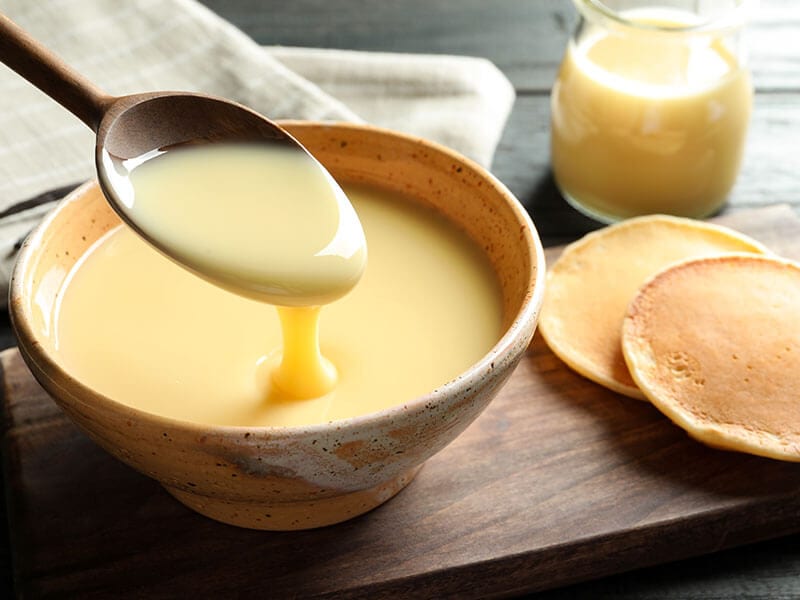
Nutrition facts (one cup/240ml): Calories: 90, Carbs: 15.2 grams, Fat: 2.4 grams, Protein: 2.2 grams, Calcium: 8% of the DV, Phosphorus: 10% of the RDI, Selenium: 7% of the RDI, Riboflavin (B2): 7% of the RDI.
Condensed milk is regular cow’s milk with its water content (around 60%) removed. You will often find the sweetened version called Sweet Condensed Milk on the market. This milk is thick and rich in sweetness.
The milk often comes in cans, and you can store it for years without refrigeration (for an unopened can). This version appeared in the 19th century and quickly became popular in Western countries.
However, Marco Polo writings show that the Tartars in the Mongol Empire created condensed milk, or a rudimentary version of it, in the 13th century. Anyway, people often use canned condensed milk for making drinks and desserts like coffee, ice cream, and some baked products.
17. Evaporated Milk
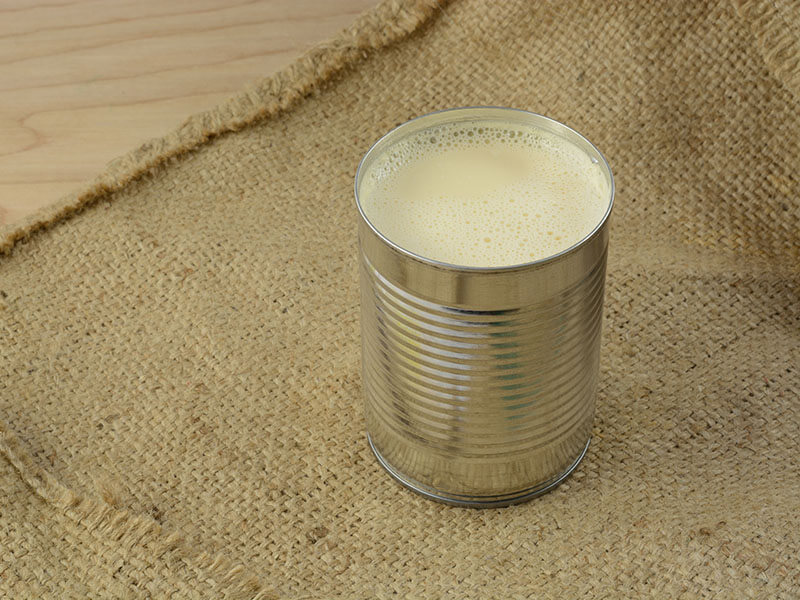
Nutrition facts (one cup/240ml): Calories: 90, Carbs: 15.2 grams, Fat: 2.4 grams, Protein: 2.2 grams, Calcium: 8% of the DV, Phosphorus: 10% of the RDI, Selenium: 7% of the RDI, Riboflavin (B2): 7% of the RDI.
Evaporated milk is the unsweetened version of condensed milk that has more than half (60%) of its water removed. So the texture is syrupy and thick, just like condensed milk. Due to the lack of sugar, evaporated milk requires better preservation.
The nutrients package of most evaporated milk has over 50% of DV (Daily Value) for calcium. You can store unopened evaporated milk cans for months without refrigeration as long as they are consumed before the expiry date.
The product is adored worldwide as a substitution for fresh milk. It is easy to ship and store this milk. You can use it to substitute condensed milk in many recipes for a mild and gentle creaminess.
People often use evaporated milk for toppings or some dessert recipes. If you want to drink it, just add water to break down the thick consistency.
Make yourself this sweet and creamy evaporated milk; why not?
18. Flavored Milk
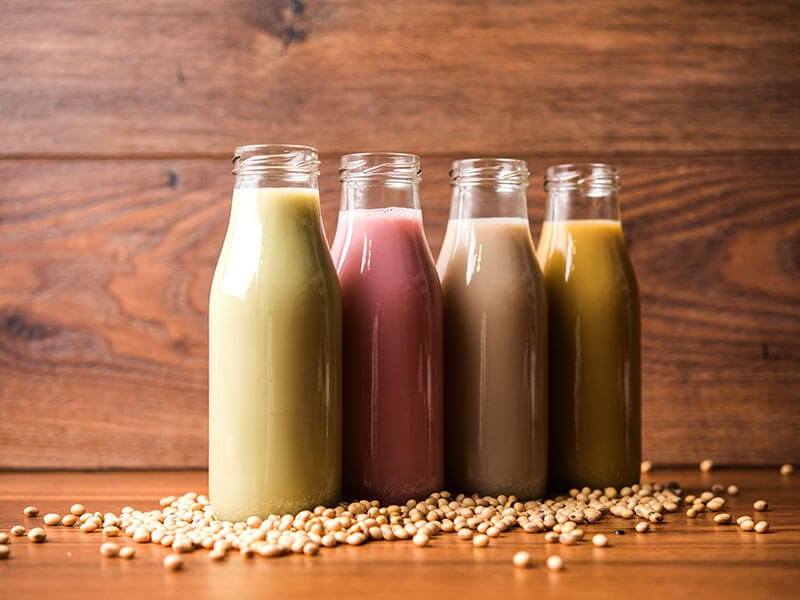
Nutrition facts (one cup/240ml) chocolate milk: Calories: 180–211, Carbs: 26–32 grams, Sugar: 11–17 grams, Fat: 2.5–9 grams, Protein: 8 grams, Calcium: 28% of the DV, Vitamin D: 25% of the RDI, Riboflavin: 24% of the RDI, Potassium: 12% of the RDI, Phosphorus: 25% of the RDI
Generally speaking, flavored milk is milk flavored with sugar, food colorings (not always), and many other different choices of flavoring like chocolate, vanilla, and so on. This milk is often available as a commercial product, but you can make it at home by flavoring your milk.
The commercial products are usually refrigerated, pasteurized, or ultra-high-temperature (UHT) treated, which doesn’t require refrigeration. Flavored milk is a common drink in Australia and other parts of the world.
In New England, flavored milk with chocolate or strawberry syrup is mixed in a milkshake machine. The outcome is a little thicker than regular milk. Some recipes also add ice cream or thickeners for the milk.
19. Buttermilk
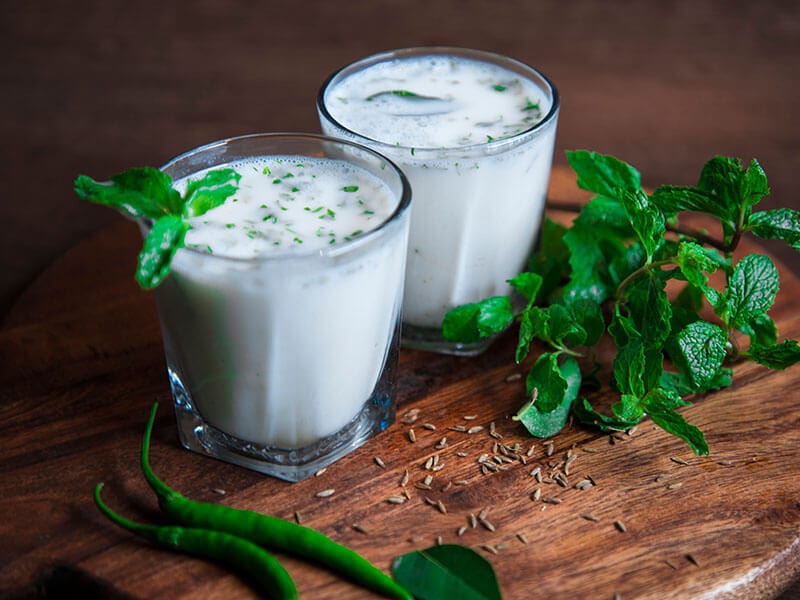
Nutrition facts (one cup/240ml): Calories: 98, Carbs: 12 grams, Fat: 3 grams, Protein: 8 grams, Calcium: 22% of the DV, Sodium: 16% of the DV, Riboflavin: 29% of the DV, Vitamin B12: 22% of the DV, Pantothenic acid: 13% of the DV
If you want to try a fermented dairy beverage, buttermilk is an excellent choice for you. Customarily, buttermilk is a byproduct of churning butter from cultured cream (or uncultured sweet cream). It is the leftover liquid resulting from this production.
When made from uncultured sweet cream, buttermilk requires another culturing step. Buttermilk is quite common in warm areas, as milk quickly turns sour. It has a mild taste with a touch of creaminess. So if the taste changes, that’s the sign showing your buttermilk has spoiled.
This milk is often used for making soda bread or a tasty ingredient in chicken or pork marination. Buttermilk is a common drink in Arab, India, and Nepal, especially during Ramadan. This type of milk is not really common in the Western region.
20. Buffalo Milk

Nutrition facts (one cup/240ml): Calories: 237, Carbs: 12 grams, Fat: 17 grams, Protein: 9 grams, Lactose: 13 grams, Calcium: 32% of the DV.
Have you ever heard about buffalo milk? This type of milk is really popular in India, Pakistan, and some countries in the Mediterranean region. In comparison, India and Pakistan are the top two countries providing buffalo milk for the world.
Water buffaloes are the main type of buffaloes contributing a large amount of buffalo milk globally. It is either from river water buffaloes or swamp buffaloes, but the former is the primary type for milk production. The other one is often used for farming.
Buffalo milk has a rich protein and fat profile, so people usually use it for making yogurt, butter, and cream.
21. Goat Milk
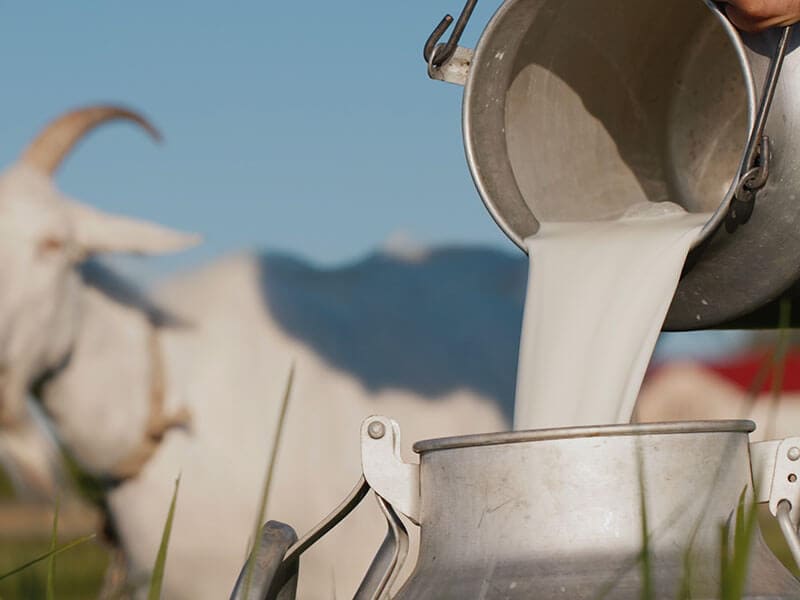
Nutrition facts (one cup/240ml): Calories: 168, Carbs: 11 grams, Fat: 10 grams, Protein: 9 grams, Sugar: 11 grams.
This dairy milk will charm you with its spectacular buttery flavor. Goat milk is a famous dairy product that accounts for 2% of the world’s total annual milk production. Raw goat milk has fat globules in it.
Goat milk’s rich fat and protein package makes it a perfect ingredient for cheese production. Goat milk has less cholesterol but more protein and calcium than other milk types.
This milk has lower lactose content than cow milk, so it could be a perfect alternative choice for those who have digestive problems. However, lactose still appears in goat milk, so if you are lactose-intolerant, read the package carefully before choosing the product.
22. Cow Milk
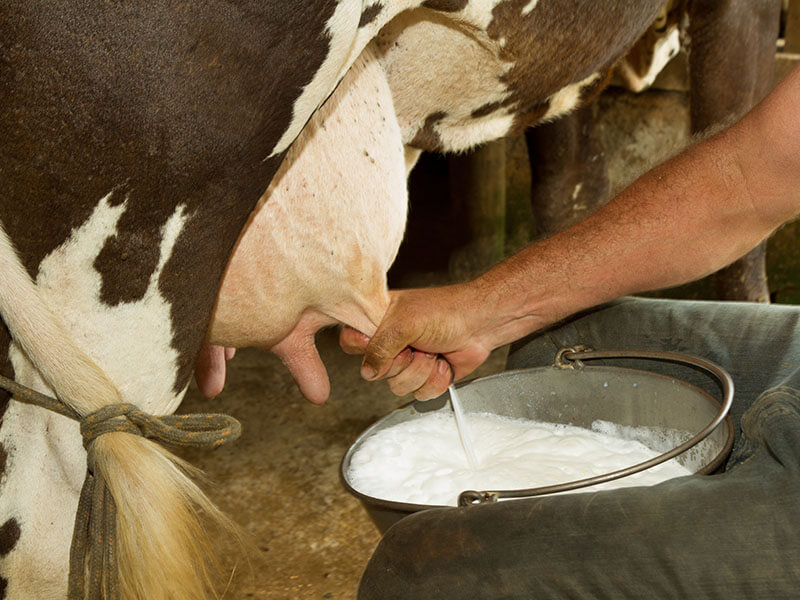
Nutrition facts (one cup/240ml): Calories: 152, Water: 88%, Protein: 8.14 grams, Carbs: 12 grams, Sugar: 12 grams, Fiber: 0 gram, Fat: 8 grams.
Here comes the most famous type of milk from animals, cow milk. Humans started drinking it some time after cattle domestication, which took place thousands of years ago. There are plenty of cow milk products that you can enjoy, such as butter, yogurt, cheese, and cream.
Cow milk is widely used because it has all the essential nutrients your body needs during the day. Regular consumption of this milk can benefit your blood pressure and strengthen your bones.
This milk has a large amount of lactose, so if you have digestive problems with the sugar, you need to pick the one labeled ‘lactose-free’.
This is how people traditionally milk a cow in a farm.
Tasty Recipes From Milk That You Should Try
Don’t forget to explore the below delicious recipes made from milk. They will give your family and you plenty of tasty and delicious meals.
Orange Creamsicle Smoothie
Want to discover the taste of combining orange juice and milk? This orange creamsicle milkshake will light up your day with an enchanting sweet and citrusy flavor. Say goodbye to the scorching summer days!
Condensed Milk Bread Rolls
Have you ever thought of mixing bread rolls and condensed milk? The soft and melty texture of bread rolls will complement condensed milk’s rich and sweet taste. Dip the bread in condensed milk and taste it; I’m sure you will love this flavor.
Almond Milk Pancakes
Wondering if you can boost the taste of your almond milk? These tasty almond milk pancakes are an ideal choice for you. The pancakes are soft with a nutty and rich taste from almond milk.
Milk Buns
These little milk buns will drive your kids crazy! The exterior is soft and covered with a layer of powdered sugar, while the interior is fluffy and sweet. Bake these buns for your upcoming parties to treat guests with a delicate sweetness.
Alfredo Sauce
Do you want to twist your pasta dish with a gentle and creamy touch from milk? Fettuccine Alfredo sauce is enriched with butter, cheese, and milk. Don’t miss out on this scrumptious recipe if you want a cozy meal for your family dinner.
Enjoy All Types Of Delicious Milk
Now you know that milk also varies with different types and many shades of flavor. So, if you love the milky taste, the recommended types of milk will suit your taste buds. If you want a mild and gentle flavor, go for plant-based milk; otherwise, animal milk is an ideal choice.
Feel free to like and share this post if you find the information helpful. Don’t hesitate to tell me what you think in the comment section. Remember to subscribe to this site for more exciting posts! Goodbye!
